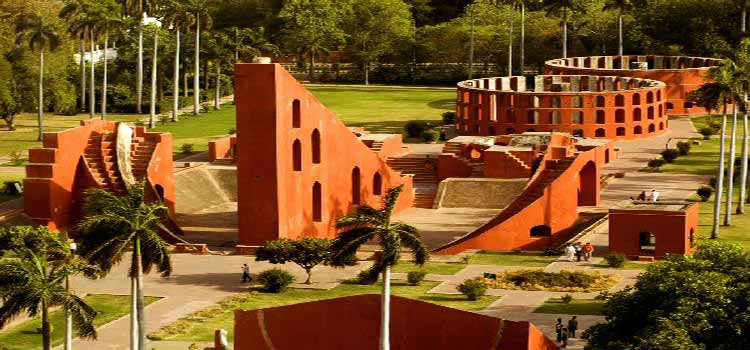How can I enjoy Jaipur in 2 days?
DAY 1: A Citadel Business
Nahargarh – Amer Fort – Jal Mahal – Markets – Zoo – Albert Hall – Moti Dungri – Birla Mandir
It will be a great idea to start your day by exploring the majestic and massive sites of Jaipur. You can start your day with the citadel of Maharaja Sawai Jaisingh II, the Nahargarh. Beautifully studded in the Aravali Range, the structure was designed in Indo-European architect as the official residence of the nine Queens of the King. Overlooking the beautiful and scenic view of Jaipur, the place can be visited at 5 in the morning. With the lights of the city looking like a pearl embellished over the black fabric, the margaritacious palace is worth waking up at this early in the morning for. But remember visitors can move inside the building only if they have tickets. If you want to visit the fort and admire its alluring and appealing architecture, you can keep this place in your list.

Nahargarh Fort
Image Source: Tourism of India
After you spend a peaceful morning watching the stars (lights) on the grounds of Jaipur, you can then go for the site seeing of Magnificent Amber palace. The distance of Amber Palace from the Nahargarh Fort is about 9 km. Here at Amber Palace, we’d recommend you to visit the temple of idol Shila Devi.

Amber Sheesh Mahal Palace
Image Source: Geek Photography
You may now get a chance to visit the beautiful Amber Palace. The Palace opens for tourists from 08:00 hrs in the morning. This UNESCO World Heritage Site combines massive defences with idyllic artistic works and is often a highlight to Jaipur. The fort stands erect at the top of a high ridge of the Aravali Range and elephants carry visitors up to the main courtyard. The tour of the entire Amber Palace will take you around one and a half hour.
The road from the stunning Amber Fort to the Market passes the Jal Mahal, which is one of the most picturesque buildings in Jaipur. The water palace appears to float at the centre of Lake Mansagar. This alluring building was once the shooting lodge of the Maharajah. The site looks beautiful, and the charm increases if you are with your friends and soulmates. There is not much to explore in this place, but the place is quite exquisite for photo session (that too in the natural light). You can also step here in the morning to look at the beautiful sun rising from the appendages of the Aravali Ranges.
The road travel time from the beautiful and magnificent Jal Mahal to the traditional markets of Jaipur. The bazaars are a treat for the ones who love to explore and discover. The bazaars are mostly located around the longevous Hawa Mahal (The Wind Palace). You can go around exploring the market and buy Jewelery from Johri Bazaar, Textiles, Local Perfumes, Shoes Made From Camel Skin (Jutties/Mojaries); Rajasthan Trinkets, and Bandhani Work from the famous Bapu Bazaar. Tripolia Bazaar and Chaura Rasta too have textile Outlets in addition to the shops selling utensils, ironware and trinkets. The Markets remain close on Sundays.
At around 16:00 hrs, when you are done shopping, you can go and watch some amazing species of birds and animals at Jaipur Zoo.
After the Zoo Spree, you can picture yourself with the beautiful backdrop of Majestic Albert Hall. And, if you are out on Thursday, you can go inside the Jaipur’s Albert Hall Museum too.

Albert Hall
Image Source: Our Jaipur
On your way back from Albert hall, you can pay a visit to the most praised Temples of Jaipur City; Moti Dungri Mandir and Birla Mandir. Every morning and evening over thousands of Jaipurites and tourists visit this Moti Dungri Temple (Built by Seth Jai Ram Paliwal) every day. The Birla Mandir of Jaipur is adjacent to the highly praised Modi Dungri Temple. The Laxmi Narayan Temple under the foot of the Moti Dungri Fort, opens darshan at 15:00 hours to 21:00 hours.

Birla Laxmi Narayan Mandir
Image Source: Rajasthan For You
DAY 2: An Ethnic Experience
City Palace – Jantar Mantar – Govind Dev Ji Temple – Chokhi Dhani
Jaipur is one of the most demanding yet gripping tourist destinations that are full of amazing experiences; from opulent to lavish palaces, Street to mall shopping, fine dining to traditional Rajasthani dinner. One day is not always enough to get a closer look of this chaotic city, so we have this planned itinerary for day 2 of your visit.
The morning focusses on the grand City Palace of Jaipur, which is the official residence of the Maharaja of Jaipur. The palace is the complex courtyard of Chandra Mahal and Mubarak Mahal palaces and some other buildings. The Chandra Mahal Palace now houses the museum but the greatest part of the city palace is still a royal residence. The gates to this lavish palace open at 09:30 hours in the morning. The entire tour of this beautiful palace cum museum will take around two to three hours.

City Palace Jaipur
Image Source: Rajasthan Direct
Right next to this beautiful Jaipur City Palace is the Jantar Mantar. The World Heritage Site was completed in 1734 AD and is biggest of all the five observatories. The instruments at Jantar Mantar were built for naked-eye observations of the celestial bodies and precision was achieved through their monumental dimensions. Generally speaking, they replicated the design of earlier instruments, but the site shows important architectural and instrumental innovations and the size of some of the instruments is among the largest in the world. To understand the mathematics and zodiacs, you’ll have to hire a guide. The tour of this place will cost you two long hours roughly.

Jantar Mantar
Image Source: Tours and Travels India
After the fair knowledge-able and intellectual visit of the observatory, we’d recommend you to pay a visit to the Govind Dev Ji Mandir (Temple). The temple of Govind Dev Ji is one of the most sacred and famous tourist destinations in India. It is located in the City Palace complex, in Jaipur, Rajasthan. The Darshan to the exquisite temple opens from 17:45 hours to 18:15 hours. The visit will cost you half an hour, and will bring peace to mind.
After the day spent at exploring and discovering the history of Jaipur and its Maharajas, Chokhi Dhani is one fine place to experience the honoured legacy of the marvellously fine warmth, generosity and hospitality of Rajasthan Culture.

Chokhi Dhani
Image Source: I Love Iskon Temple
Best Month to Visit Jaipur
The best seasons to visit the royal land of Jaipur are the Spring Fall and the Winter season from September through to February. This is the time of the year the city of Jaipur observes the highest number of tourists. Owing to the cool and icy weather of the winter, the places like Nahargarh, Jaigarh, and Amber fort look more beautiful than ever.












